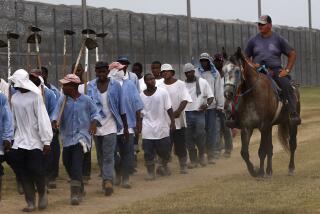Bone Dry in South Texas : Ranchers Relying on Cactus to Keep Herds From Starving
- Share via
LAREDO, Tex. — Rancher Charley Neely 36, and his wife, Janet, 27, trudged through the bone-dry dusty ranchland in the early morning hours and late afternoon setting fire to acres of prickly pear cactus, burning thousands of spiny thorns off each plant.
Each carries an over-the-shoulder tank weighing 50 pounds, filled with 3 1/2 gallons of butane. Connected to the tank is a small hose linked to a four-foot-long tube capped with coil inside a metal bonnet.
When they release butane into the tube and drop a match into the bonnet, a deafening blast occurs. When the butane hits the red-hot coil it vaporizes.
Hungry cattle run toward the loud noise. They know it means food.
No Rain Since August
As soon as the Neelys finish burning thorns off one prickly pear plant and go to another, cattle move in and quickly gobble up dethorned cactus for nourishment--all of it, pears, big green leaves, the trunk.
For three months, thousands of ranchers south of San Antonio and west of the Rio Grande Valley have kept herds of cattle alive by burning prickly pear thorns.
There hasn’t been any appreciable rain in this part of the country since August. South Texas is in the midst of one of the worst droughts in years. There’s no grass for hundreds of miles, only prickly pear and mesquite trees. Prickly pear cactus is the only natural feed available, and the cattle are unable to eat it unless the thorns are burned off.
“Cattle are starting to die off on some of the ranches that have run out of water, out of prickly pear and out of grass. So far we’ve been lucky. We still have water left in our reservoirs and plenty of cactus,” Neely said.
“We keep the cattle moving everyday as they munch through miles of prickly pear. If it doesn’t rain soon, we’ll have to sell off the animals so they don’t starve. We don’t want to. Many Texas ranchers have already moved their cattle to market because of the drought.”
The Neelys run 400 cattle on 14,000 acres of leased land. Normally they would have 600 head, but the numbers are down because of lack of rainfall.
There are 13.5 million cattle and calves on 146,000 ranches in Texas, almost as many cows as people, making Texas the No. 1 cattle state. There are 98 million cattle in the United States.
Requests Government Aid
With cattle and calves averaging $407 a head, said Michael A. Jones, spokesman for the Texas Department of Agriculture in Austin, it is a $4.55 billion annual industry for the Lone Star state.
“Over one-third of Texas is suffering under one of the worst droughts of an already dry decade,” noted Deputy State Agriculture Commissioner Mike Moeller, himself a rancher in South Texas, the hardest hit area where 875,000 head of cattle graze. “South Texas is burning in the sun,” lamented Moeller.
Jim Hightower, commissioner of Agriculture and Gov. Bill Clements have asked U.S. Agriculture Secretary Richard Lyng for emergency drought relief programs for livestock producers in 103 Texas counties. They have requested the implementation of the Emergency Food Grain Program to provide livestock feed to the cattlemen.
“We have had less than five inches of rain since last July in the Laredo area. Normal rainfall for the period is 16 inches,” said veterinarian H. Q. Sibley, 68, a rancher here since the late 1940s.
“Few people outside South Texas ever heard of burning prickly pear cactus for cattle feed. Most Texans don’t know anything about this. It’s something unique to our area, something that has been going on in this country for 150 years whenever it gets extremely dry and the range grass dies. In the old days ranchers burned the prickly pear cactus with sticks,” explained Sibley.
Burning Prickly Pear
He said it’s costing him $7,500 more a month to “pear burn” for his 400 head of Beefmaster Cattle. “In normal times the animals are grazed in natural grass. Now it means added labor costs, money for burning equipment, for fuel, for supplemental feed.”
Prickly pear cactus, noted Sibley, provides roughage and bulk but not much protein. He and other ranchers in the Laredo area mix tons of two parts cottonseed meal and one part salt as supplemental feed to provide the animals with protein.
One of his ranch hands drives 250 miles round trip every other week to buy 10 tons of cottonseed meal at $172 a ton and buy five tons of salt locally at $118 a ton.
“Our cowboys are spending full time burning prickly pear and putting out the supplemental feed and have no time to work on fences, windmills and do the other work they’d normally be doing this time of the year,” he said.
Ranchers say to feed the animals hay in this type of dry sprawling rugged country where one cow on an average grazes on 20 to 25 acres would be prohibitive.
A few head of his cattle have already died from “pear ball,” which occurs when cactus fibers accumulate into balls inside the animals’ stomach and forms a blockage.
Charley and Janet Neely have been spending six to eight hours a day, seven days a week burning prickly pear cactus since late February to save their herd from starvation.
They were drenched with sweat from the heat of the pear burner and from the sweltering sun. Come July and August they said the temperature would soar to 110 to 115 degrees. Their two daughters, Diane, 5 and Emily, 3, accompany them in their pickup on their daily burning expeditions.
TEXAS AGRICULTURE AT A GLANCE
Cattle raising is by far the biggest agricultural industry in Texas; figures are 1986 cash receipts.
Livestock $5.5 billion
Cattle 4.1 billion
Poultry/eggs 637.8 million
Dairy 552.3 million
Wool 88.4 million
Hogs 81.0 million
Sheep 74.7 million
Crops $2.9 billion
Cotton 775.6 million
Feed grains 732.4 million
Miscellaneous 490.5 million
Food grains 374.6 million
Vegetables 369.4 million
Peanuts/soybeans/sunflowers 144.5 million
Fruits/nuts 41.3 million
Source: Texas Agricultural Statistics Service
Los Angeles Times
More to Read
Sign up for The Wild
We’ll help you find the best places to hike, bike and run, as well as the perfect silent spots for meditation and yoga.
You may occasionally receive promotional content from the Los Angeles Times.






